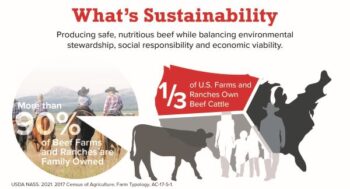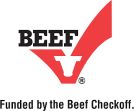Stats for Beef Production in the Us Environment
 American beef cattle farmers and ranchers have known for generations how important it is to keep their animals healthy and contented. Their delivery to providing quality intendance proves itself in the data: U.S. herds represent only half dozen% of the world's cattle yet provide 18% of the globe's beef, (FAO, 2018)
American beef cattle farmers and ranchers have known for generations how important it is to keep their animals healthy and contented. Their delivery to providing quality intendance proves itself in the data: U.S. herds represent only half dozen% of the world's cattle yet provide 18% of the globe's beef, (FAO, 2018)
In contrast, India and Brazil avowal beefiness operations twice that of the U.S., still produce just 6.5% and 18%, respectively (FAS, 2021). Beef cattle production, from feed product to animals leaving the feed chiliad, represents 3.vii% of U.S. greenhouse gas emissions (Rotz et. al, 2018). Whether grain- or grass-finished, American beef cattle spend 2-thirds of their lives grazing on country that is unsuitable for crops, converting rangeland into safe, accessible poly peptide for millions of people.
Environmental Stewardship: A delivery to continuous improvement
- By embracing scientific inquiry and best practices, American beef cattle farmers and ranchers have avoided 2.3 gigatons of carbon emissions since 1975 (FAO, 2018).
-
 Beef is every bit efficient as pork and poultry when it comes to meat product, requiring just 2.6 kgs per kg (2.six lbs. of grain per lb.) of beef carcass weight (Rotz et. al, 2018).
Beef is every bit efficient as pork and poultry when it comes to meat product, requiring just 2.6 kgs per kg (2.six lbs. of grain per lb.) of beef carcass weight (Rotz et. al, 2018). - The U.S. has had the lowest beef GHG emissions intensity in the world since 1996 (FAO, 2018). Between 1961 and 2018, the U.S. beef industry, through continued sustainability efforts and improved resource use, has reduced emissions per pound of beefiness produced by more 40% while also producing more than than 66% more beef per animal (FAO, 2018; NASS 2021). The U.S. beefiness production system has the everyman contribution to global greenhouse gas emissions relative to its contribution to global beefiness production (BCI, 2020).
- Cattle do more than recycle – they upcycle inedible plants into high-quality protein.
- Beef cattle generate three times more protein than they eat considering their unique digestive system allows them to catechumen human-inedible plants into loftier-quality poly peptide (Baber, et. al, 2018). This power is central to providing useful calories, protein, and an abundance of vitamins for an e'er-escalating world population.
- More than than xc% of what cattle consume is forage and plant leftovers that are inedible for humans (Broocks et. al, 2017).
- More than 29% of the land in the U.Southward. is pasture and rangeland that is besides rocky, steep, and/or barren to support cultivated agriculture – still cattle thrive there, coexisting with natural ecosystems while potentially mitigating wildfire risks (ERS, 2021A).
Social Responsibility: – A commitment to future generations
- More than than 90% of beef farms and ranchers are family owned. Based on the NASS 2017 Census of Agriculture, the boilerplate beef cow herd is 43.5 head (NASS, 2017).
- Beef cattle farmers and ranchers who rely on this land for income run for elected office and contribute straight and indirectly to public civilities such equally schools. Approximately 39% of beefiness cattle farmers and ranchers volunteer with civic organizations (NCBA, 2017).
- The Beefiness Quality Assurance (BQA) program represents more than 80% of U.S. beef supply, and members are trained in sustainability and welfare standards, and are kept up-to-date with the latest innovations, training, and protocols to ensure their animals and farms are cared for properly.
- Meat and poultry is ane of the about regulated industries in America. Each processing site is required to have USDA inspectors on site continuously – this protects both animals and consumers, equally inspectors are able to stop production immediately if concerns arise.
- Because 78% of cattlemen and women intend to pass their farm on to their children, they strive to go out the country, water and other natural resources in meliorate shape than when they acquired them (NCBA, 2017). A survey of over 700 U.S. beef cattle farmers and ranchers, representing more 4.39 million animals and 14 million acres of state, plant that 99.8% of respondents employ at least one water quality comeback exercise, such equally providing h2o sources abroad from surface water, providing feed or supplementation sites away from surface h2o, and implementing grazing plans (Loy et. al, 2017).
 Economic Profitability: A commitment to long-term viability
Economic Profitability: A commitment to long-term viability
- Co-ordinate to the U.South. Department of Agriculture Economic Research Service, in 2018 the economic touch of the beef manufacture was $66.24 billion in farm gate receipts for cattle and calves (ERS, 2019).
- Cattle production is the nigh important agricultural industry in the United states of america, consistently accounting for the largest share of total cash receipts for agricultural commodities. In 2021, cattle product is forecasted to represent about 17 percent of the $391 billion for agronomical commodities (ERS, 2021B). In 2020, U.S. beef exports totaled 2.96 billion pounds.
Unintended consequences of eliminating beefiness
- According to enquiry published in the Proceedings of the National Academies of Sciences, if all livestock in the U.S. were eliminated and every American followed a vegan diet, greenhouse gas emissions would only be reduced by 2.6%, or 0.36% globally. This would lead to an increment in the apply of synthetic fertilizer and increased soil erosion. Americans would also need to figure out a way to get vitamin B12 (found almost but in animal products), which is responsible for forming ruddy blood cells properly, synthesizing DNA, and neurological function.
Sources:
- Baber, J.R. et al., 2018. Estimation of human-edible protein conversion efficiency, net poly peptide contribution, and enteric methane product from beef product in the The states. Trans. Anim. Sci. 2: 439-450
- BCI. 2020. Intensification of Beefiness Production Aids in Sustainable Beefiness Product. Kansas Land University
- Broocks et. al. 2017. Corn as Cattle Feed vs. Man Food. Oklahoma Land University
- CA Rotz, S Asem-Hiablie, Due south Place, Yard Thoma., 2018. Environmental footprints of beef cattle production in the Usa. Agronomical Systems. Advance online publication. doi.org/ten.1016/j.agsy.2018.11.005
- ERS. 2019. Cash Receipts by Country. USDA
- ERS. 2021 A. 2012 ERS Major Uses of Land. USDA
- ERS. 2021 B. Sector at a Glance. USDA
- FAO. 2018. UN FASTAT
- FAS. 2021. Livestock and Poultry: World Markets and Trade. USDA
- Feedyard Assessment. 2021. Database. NCBA
- Loy, et al. 2017. Water Quality and Beef Sustainability. Beefresearch.org.
- NCBA. 2017 Cattlemen's Stewardship Review. 2017
- NASS. 2021. Quickstats. USDA
- White, RR and Hall, MB. Nutritional and greenhouse gas impacts of removing animals from U.s.a. agronomics. Proceeding of the National Academies of Scientific discipline (2017)
- Infographic: https://www.beefitswhatsfordinner.com/marketing-resources/infographic-library
octomancleaskulty.blogspot.com
Source: https://thesustainabilityalliance.us/u-s-beef-fact-sheet/